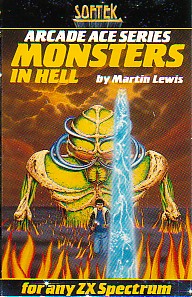
Wonder Boy in Monster Land, known by its original arcade release as Wonder Boy: Monster Land, is a platform video game developed by Westone Bit Entertainment and released by Sega in Japanese arcades in 1987 and for the Master System in 1988, with a number of other home computer and console ports following. The game is the sequel to the 1986 game Wonder Boy and takes place eleven years after the events in the previous game. After enjoying over a decade of peace on Wonder Land following the defeat of the evil King by Tom-Tom, later bestowed the title "Wonder Boy", a fire-breathing dragon called the MEKA dragon appeared; he and his minions conquered Wonder Land, turning it into "Monster Land". The people, helpless due to their lack of fighting skill, call for Wonder Boy, now a teenager, to destroy the monsters and defeat the MEKA dragon. Players control Wonder Boy through twelve linear levels as he makes his way through Monster Land to find and defeat the MEKA dragon. Players earn gold by defeating enemies and buy weapons, armor, footwear, magic, and other items to help along the way.

Lode Runner is a 2D puzzle-platform game, developed by Doug Smith and published by Broderbund in 1983. Its gameplay mechanics are similar to Space Panic from 1980. The player controls a character who must collect all the gold pieces in a level and get to the end while being chased by a number of enemies. It is one of the first games to include a level editor.

Painkiller is a first-person shooter video game developed by Polish game studio People Can Fly and published by DreamCatcher Interactive in April 2004 for Microsoft Windows and ported to Xbox in 2006. The game's single player campaign follows a dead man in Purgatory who is offered a deal to defeat the invading forces of Lucifer's army in exchange for being allowed to enter Heaven. The game was particularly well-received for its multiplayer experience and was featured for two seasons on the Cyberathlete Professional League's World Tour.
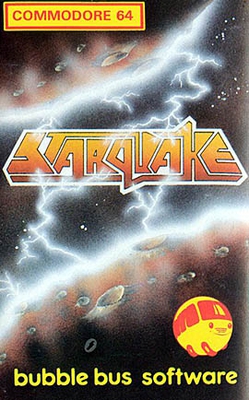
Starquake is an action-adventure platform game written by Stephen Crow for the ZX Spectrum and published by Bubble Bus Software in 1985. It was ported to the Commodore 64, MSX, Amstrad CPC, Atari 8-bit computers, Tatung Einstein, BBC Micro (1987), and IBM compatibles and Atari ST.

3D Monster Maze is a survival horror computer game developed from an idea by J.K. Greye and programmed by Malcolm Evans and released in 1981 for the Sinclair ZX81 platform with the 16 KB memory expansion. The game was initially released by J. K. Greye Software in December 1981 and re-released in 1982 by Evans' own startup, New Generation Software. Rendered using low-resolution character block "graphics", it was one of the first 3D games for a home computer, and one of the first games incorporating typical elements of the genre that would later be termed survival horror.

Mr. Do's Castle is a platform game released in arcades by Universal in September 1983. In Japan, the game is titled Mr. Do! versus Unicorns. Marketed as a sequel to the original Mr. Do! released one year earlier, the game bears a far closer resemblance to Universal's Space Panic from 1980. It began as a game called Knights vs. Unicorns, but the U.S. division of Universal persuaded the Japanese arm to modify the graphics into a Mr. Do! game following the first game's popularity.

The Horace video game series was created in the 1980s by William Tang for Beam Software. The series comprised Hungry Horace, Horace Goes Skiing and Horace and the Spiders.

Aaargh! is a single-player action video game in which the player controls a giant monster with the goal of obtaining eggs by destroying buildings in different cities across a lost island. It was designed for Mastertronic's Arcadia Systems, an arcade machine based on the custom hardware of the Amiga, and was released in 1987. It was ported to a range of other platforms and released on these across 1988 and 1989. Electronic Arts distributed the Amiga version of the game.

Gunfright is an action-adventure game developed by Ultimate Play the Game and published by U.S. Gold. It was first released for the ZX Spectrum in December 1985, then released for Amstrad CPC and the MSX the following year. The player takes the role of a sheriff in the town of Black Rock and is tasked with eliminating outlaws who are scattered throughout the settlement.
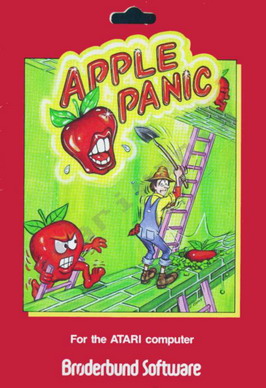
Apple Panic is a game for the Apple II programmed by Ben Serki and published by Broderbund Software in 1981. Apple Panic is an unauthorized version of the 1980 arcade game Space Panic, the first game with ladders and platforms. While the arcade original remained obscure, Apple Panic became a top seller for home computers. It was ported to the Atari 8-bit computers, VIC-20, IBM PC, and TRS-80.
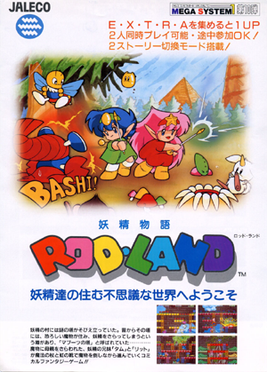
Rod Land, known in Japan as Yōsei Monogatari Rod Land, is a 1990 platform game originally developed and published in arcades by Jaleco.

Space Panic is a 1980 arcade video game developed by Universal. Predating Nintendo's Donkey Kong, and lacking a jump mechanic, Space Panic was the first game involving climbing ladders between walkable platforms. The genre was initially labeled "climbing games", but later became known as platform games. A ColecoVision port by CBS Electronics was released in the winter holiday season of 1982.

Cauldron II: The Pumpkin Strikes Back is a video game developed and published by British developer Palace Software as a sequel to their 1985 game Cauldron. The 2D platform game was released in 1986 for the ZX Spectrum, Commodore 64, and Amstrad CPC home computers. Players control a bouncing pumpkin that is on a quest of vengeance against the "Witch Queen". The roles of the two were reversed from the first game, in which the witch defeated a monstrous pumpkin.
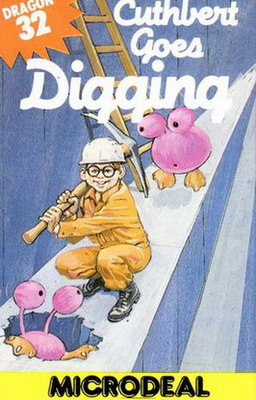
Cuthbert Goes Digging is a 1983 video game for the Dragon 32 home computer. Written by Steve Bak at Microdeal, the game features the hero Cuthbert, who also appears in Cuthbert Goes Walkabout and Cuthbert in the Mines. In the game, the player guides Cuthbert through levels of girders, avoiding 'moronians' fatal to the touch.
Dynamite Dan is a platform game written by Rod Bowkett for the ZX Spectrum and published by Mirrorsoft in 1985. It was ported to the Amstrad CPC, Commodore 64, and MSX.

Action Force: International Heroes is a video game released by Virgin Games in 1987 for the ZX Spectrum and Commodore 64, and in 1988 for the Amstrad CPC. The game is set in the world of the Action Force toys by Hasbro. The ZX Spectrum version of the game differs notably from the Commodore and Amstrad versions.

Heiankyo Alien, known as Digger in North America, is a maze video game created by The University of Tokyo's Theoretical Science Group (TSG) in 1979. The game was originally developed and released as a personal computer game in 1979, and was then published by Denki Onkyō Corporation as an arcade game in November 1979. In 1980, the arcade game was released in North America as Digger by Sega-Gremlin, with minor changes in appearance.
Roland was a game character developed in 1984 by Alan Sugar, CEO of Amstrad, and Jose Luis Dominguez, a Spanish game designer. The character was named for Roland Perry, a computer engineer who worked for Amstrad. The idea was to have one recognizable character in a number of different computer games in a bid to have the Amstrad CPC compete with the ZX Spectrum and the Commodore 64.

The Real Ghostbusters is a 1987 shoot 'em up arcade game developed and published by Data East. It is loosely based on Ghostbusters. In Japan, Data East released it as a non-Ghostbusters arcade game under the title Meikyuu Hunter G. In 1989, Activision published The Real Ghostbusters for Amiga, Amstrad CPC, Atari ST, Commodore 64, and ZX Spectrum.

Hell Yeah! Wrath of the Dead Rabbit is a platform game for Microsoft Windows, PlayStation 3 through PlayStation Network, Xbox 360 through Xbox Live Arcade, and iOS through App Store. It was developed by French developer Arkedo Studio and published by Sega. The game has an ESRB rating of Teen.
